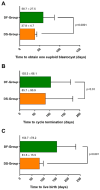DuoStim Shows Comparable Efficacy but Better Efficiency than Two Conventional Stimulations in Poor/Suboptimal Responders Undergoing Vitrified Oocyte Accumulation for PGT-A
- PMID: 40566552
- PMCID: PMC12193753
- DOI: 10.3390/life15060899
DuoStim Shows Comparable Efficacy but Better Efficiency than Two Conventional Stimulations in Poor/Suboptimal Responders Undergoing Vitrified Oocyte Accumulation for PGT-A
Abstract
This study compared the DuoStim protocol with two conventional follicular phase stimulations for vitrified oocyte accumulation in poor-prognosis patients undergoing PGT-A. A retrospective analysis of 112 IVF cycles was conducted, with 66 cycles among patients undergoing DuoStim (DS-Group) and 46 among patients undergoing conventional follicular phase stimulations (DF-Group). The primary outcome was the time to live birth, while secondary outcomes included clinical pregnancy rate, miscarriage rate, live birth rate, and cumulative live birth rate. The final analysis included 66 patients in the DS-Group and 40 in the DF-Group, as 6 women (13%) in the DF-Group discontinued treatment after the first stimulation. Oocyte yield was similar between groups (8.4 ± 3.9 in DS-Group vs. 8.2 ± 4.0 in DF-Group, p = 0.80), as was the number of euploid blastocysts (0.9 ± 1.2 vs. 1.1 ± 1.1, p = 0.37). The cumulative live birth rate was 22.7% in the DS-Group and 25% in the DF-Group (multivariate odds ratio adjusted for maternal age and male factor: 1.05, p = 0.93). The time to live birth was significantly shorter in the DS-Group (81.5 ± 15.5 days) compared to the DF-Group (153.7 ± 78.2 days, p < 0.001). DuoStim showed similar efficacy but a shorter time to live birth.
Keywords: DuoStim; follicular phase stimulation; oocyte accumulation; oocyte vitrification; time to live birth.
Conflict of interest statement
The authors declare no conflicts of interest.
Figures


References
-
- Moffat R., Pirtea P., Gayet V., Wolf J.P., Chapron C., de Ziegler D. Dual ovarian stimulation is a new viable option for enhancing the oocyte yield when the time for assisted reproductive technnology is limited. Reprod. Biomed. Online. 2014;29:659–661. doi: 10.1016/j.rbmo.2014.08.010. - DOI - PubMed
-
- Ubaldi F.M., Capalbo A., Vaiarelli A., Cimadomo D., Colamaria S., Alviggi C., Trabucco E., Venturella R., Vajta G., Rienzi L. Follicular versus luteal phase ovarian stimulation during the same menstrual cycle (DuoStim) in a reduced ovarian reserve population results in a similar euploid blastocyst formation rate: New insight in ovarian reserve exploitation. Fertil Steril. 2016;105:1488–1495.e1. doi: 10.1016/j.fertnstert.2016.03.002. - DOI - PubMed
LinkOut - more resources
Full Text Sources
Miscellaneous

